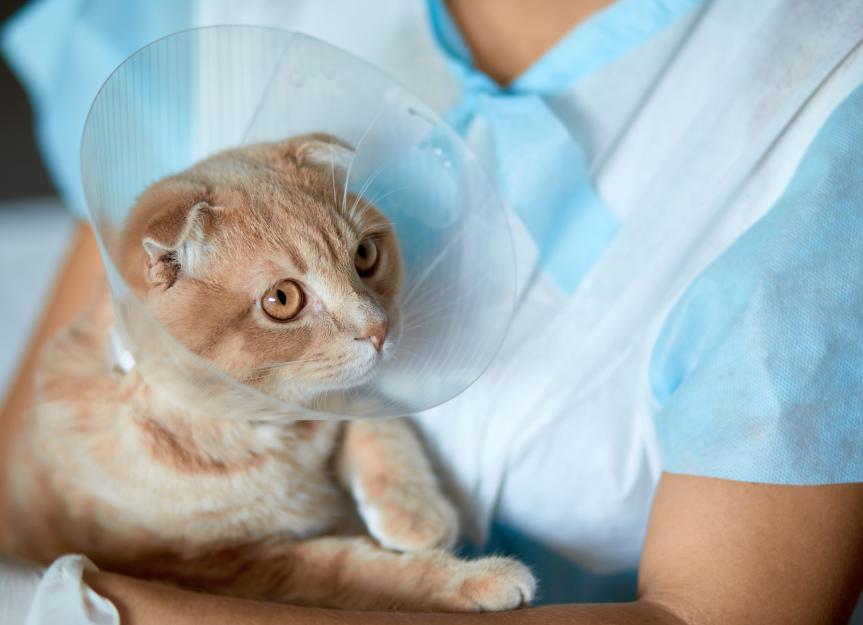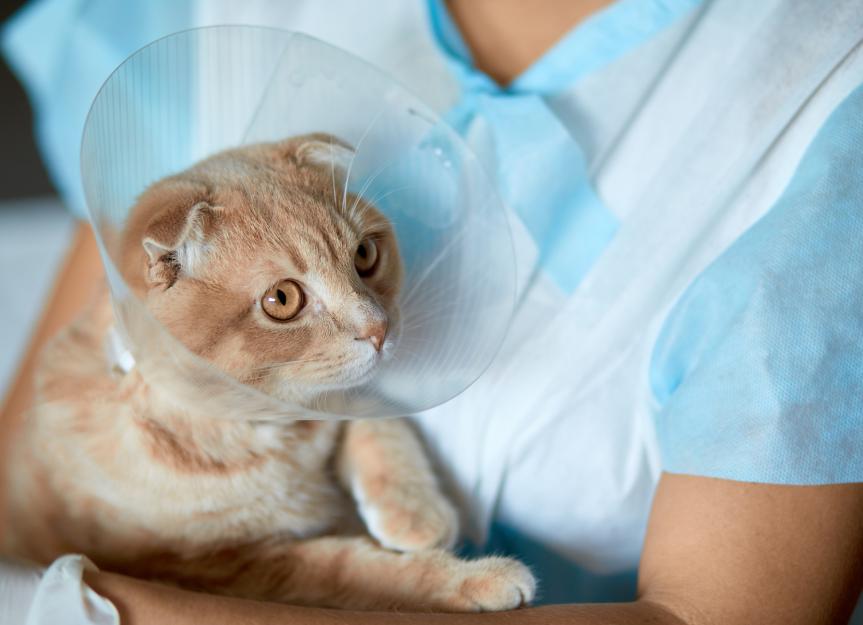
If you’ve ever gotten a new kitten, you’ve likely heard your veterinarian discuss a cat spay at her first checkup.
A cat spay is a routine preventive surgery that helps control the pet population and reduces the risk for many unwanted health conditions, such as pyometra and mammary cancer.
This surgery is commonly done at your local veterinary hospital or spay and neuter clinics.
Key Takeaways
- Spaying your cat prevents pregnancy and offers major health benefits, including a reduced risk of mammary cancer and uterine infections.
- The procedure is routine and safe, with a low complication rate, and costs typically range from $50–$500 depending on the clinic.
- Recovery takes 10–14 days and involves limited activity, pain management, and monitoring for signs of infection at the incision site.
What Is a Cat Spay?
A cat spay is a surgical procedure done by a veterinarian to remove the cat’s ovaries and uterus.
This prevents the cat from getting pregnant with kittens and reduces the risk of mammary cancer later in life.
Spays are extremely common procedures with most household cats having them done while they were kittens.
A cat spay is a routine preventive surgery that helps control the pet population and reduces the risk for many unwanted health conditions.
Shelters and animal rescues routinely spay cats before adopting them out to pet parents as well.
It is recommended to spay cats prior to their first heat cycle. Cats can be spayed during heat but it is not advised. Spaying a cat during heat carries increased risk of complications, such as excessive blood loss, greater pain, and longer recovery times.
What Happens During a Cat Spay?
When a cat is spayed, she must undergo general anesthesia. To prepare, a veterinarian does a thorough physical exam on the cat. The heart and lungs will be listened to closely to find any abnormalities that may be problematic for anesthesia.
Sometimes, blood work or urinalysis may be done to make sure there are no underlying health issues. Once the veterinarian decides the cat will be safe during anesthesia, her surgery preparation can begin.
The veterinarian will give your cat some medication to keep her calm. A small area of your cat’s forearm will be shaved and cleaned so that a catheter can be placed into her vein. This catheter is used for emergency access and to give fluids during the surgery if needed.
Medication will be given directly into your cat’s vein to start anesthesia. An endotracheal tube will be placed into her throat to allow oxygen and inhaled anesthesia to be given during the surgery.
Monitoring equipment, such as an EKG or pulse oximeter, is attached to ensure your cat’s safety during the spay.
Once your cat is anesthetized and being monitored, a small area of the belly will be shaved and scrubbed clean before the veterinarian starts the spay.
During the spay, a small cut is made in the cat’s lower belly through which a veterinarian surgically removes the ovaries and uterus. Afterward, the belly is closed with stitches, and your cat is woken up from anesthesia.
Why Do Cats Need To Be Spayed?
Cats should be spayed to prevent future pregnancies and to promote overall health and well-being. A spay has many specific benefits, including:
Risks of a Cat Spay
Cat spaying is a safe procedure with a low complication rate. The risk of a cat having a serious complication, such as death, from a spay is extremely low, with studies citing a 0.05% mortality rate.
Most spays are done on young, healthy cats, which reduces the likelihood of complications. While rare, potential risks involved with a spay include:
Pet parents should always ask their veterinarian any questions they have before the procedure.
Spaying a cat during heat carries increased risk of complications, such as excessive blood loss, greater pain, and longer recovery times.
Your veterinarian can address any concerns, explain what a pet parent can expect in detail for the spay procedure, and explain any risks from the surgery for their particular cat.
Effectiveness of a Cat Spay
Studies have shown that spaying cats is highly effective and safe. One study from a high-volume spay and neuter clinic noted that the survival rate for cat spays was 99.95%.
Pyometra is a serious concern for unspayed cats, but the risk of a spayed cat developing this condition is nearly zero since the uterus has been removed. Additionally, a study showed that cats who are spayed before 6 months of age had a 91% reduced risk for mammary cancer compared to intact cats.
Cost of a Cat Spay
Cat spays can range anywhere from $50–$500 depending on the location and type of facility the surgery is done at. Spay and neuter clinics are less expensive than full-service veterinary hospitals. Some businesses, including shelters, may offer free spays.
If pet parents are having difficulty affording this procedure, they can apply for CareCredit, choose a local spay and neuter clinic, or ask about any incentives being offered at an animal shelter or through the local veterinary teaching hospital.
Preparation for a Cat Spay
The night before a cat spay, pet parents should follow their veterinarian’s instructions about food and water. Typically, it’s recommended to withhold food for 12 hours before the surgical procedure, but this can vary on a case-by-case basis.
Water is generally OK to keep in your cat’s bowl.
Be sure to ask your veterinarian about specific instructions related to any medications your cat may be taking.
Because many cats become anxious when having to travel in the car, your veterinarian may prescribe a light sedative, such as trazodone, to relax your cat before the trip to the veterinary hospital.
Pet parents can also use Feliway spray or diffusers in the cat carrier and the areas where the cat will stay before getting into the car.
Post-Op Care and Recovery for a Cat Spay
Cats generally recover within 10 to 14 days following surgery. During this time, cats will need to wear a cone to prevent them from licking their incisions.
They should also be kept in a quiet area where their activity, such as running and jumping, can be limited.
A recheck by the veterinarian will be done after 10 to 14 days to ensure the incision site has healed correctly. Pain medications, such as Onsior, may be prescribed to keep a recovering cat comfortable.
During recovery, pet parents should watch for signs of infection or inflammation (swelling) at the incision site that may develop after surgery. These may include:
If you notice any of these signs, call your vet for guidance to prevent complications.
Alternatives to a Cat Spay
There are no widely accepted alternatives to the spay procedure for cats.
There is ongoing research to explore different options with one specifically studying gene therapy as a form of contraception (birth control) for cats, according to the American Veterinary Medical Association (AVMA).
It’s not known when or if any alternatives may eventually be offered to pet parents.
Cat Spay FAQs
How much does spaying a cat usually cost?
The costs of spaying a cat can vary widely depending on location and the type of clinic chosen. Many shelters offer free spays. Local veterinarians and spay and neuter clinics may charge anywhere from $50–$500.
Do female cats change after being spayed?
Spaying reduces negative behaviors, such as aggression and roaming. It can also cause cats to gain extra weight over time.
What is the best age to spay a female cat?
The best age to spay a female cat is when they are young, specifically before their first heat cycle. This generally occurs around 6 months of age.
How long does it take for a female cat to heal after being spayed?
Cats generally recover from a spay within 10–14 days.
What is a cat spay?
A cat spay is a surgical procedure done by a veterinarian to remove the cat’s ovaries and uterus. This prevents future pregnancy and reduces the risk of several health conditions.
Is spaying painful for cats?
The actual spay procedure is not painful for cats because they are under general anesthesia and cannot feel anything. However, during recovery, cats can have pain at the surgical site, which is managed with pain medications.
References
Levy, JK, Bard, KM, et al. Perioperative mortality in cats and dogs undergoing spay or castration at a high-volume clinic. The Veterinary Journal. 2017;224: 11-15. https://doi.org/10.1016/j.tvjl.2017.05.013.



